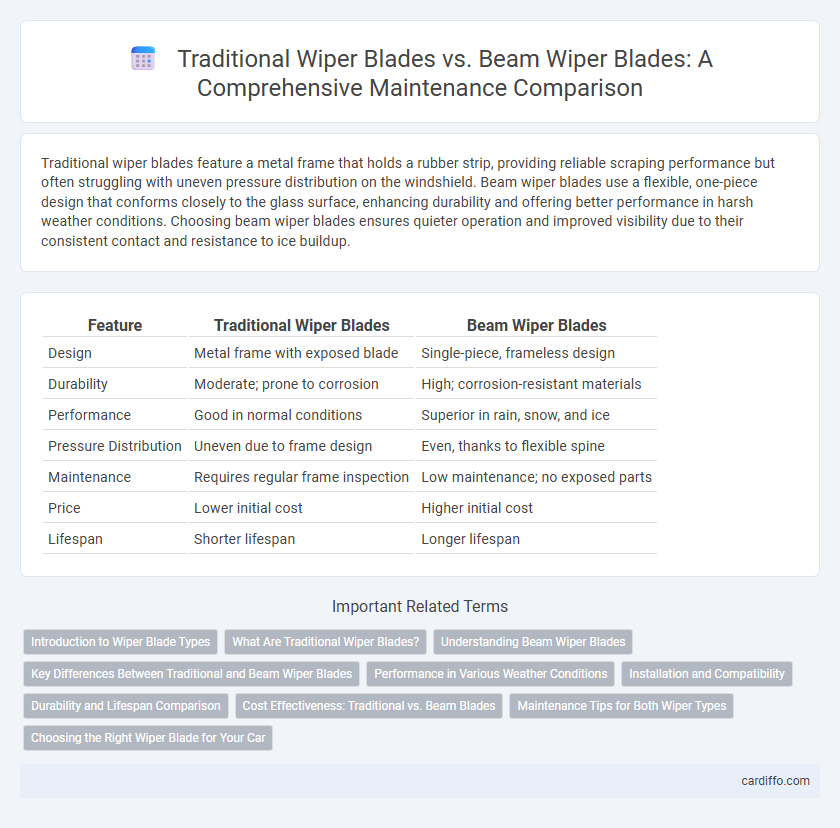Traditional wiper blades feature a metal frame that holds a rubber strip, providing reliable scraping performance but often struggling with uneven pressure distribution on the windshield. Beam wiper blades use a flexible, one-piece design that conforms closely to the glass surface, enhancing durability and offering better performance in harsh weather conditions. Choosing beam wiper blades ensures quieter operation and improved visibility due to their consistent contact and resistance to ice buildup.
Table of Comparison
| Feature | Traditional Wiper Blades | Beam Wiper Blades |
|---|---|---|
| Design | Metal frame with exposed blade | Single-piece, frameless design |
| Durability | Moderate; prone to corrosion | High; corrosion-resistant materials |
| Performance | Good in normal conditions | Superior in rain, snow, and ice |
| Pressure Distribution | Uneven due to frame design | Even, thanks to flexible spine |
| Maintenance | Requires regular frame inspection | Low maintenance; no exposed parts |
| Price | Lower initial cost | Higher initial cost |
| Lifespan | Shorter lifespan | Longer lifespan |
Introduction to Wiper Blade Types
Traditional wiper blades feature a metal frame that supports a rubber blade, providing reliable performance but often leading to uneven pressure distribution and streaking over time. Beam wiper blades utilize a one-piece, tensioned design with no external frame, allowing for consistent contact with the windshield and improved durability in varying weather conditions. Choosing between these types impacts visibility and maintenance frequency, with beam blades generally offering enhanced aerodynamic performance and reduced noise.
What Are Traditional Wiper Blades?
Traditional wiper blades consist of a metal frame with multiple pressure points that hold a rubber blade, designed to conform to the windshield's surface for effective water removal. These blades are typically heavier and more prone to wear and tear due to their multiple moving parts and exposed structure. Maintenance often involves regular inspection and replacement to ensure clear visibility and safe driving conditions.
Understanding Beam Wiper Blades
Beam wiper blades feature a one-piece, flexible design that provides consistent pressure across the windshield, improving performance in harsh weather compared to traditional wiper blades with metal frames. Their aerodynamic shape reduces wind lift and noise, enhancing visibility during rain, snow, and ice conditions. Made from durable silicone or synthetic rubber, beam blades offer longer lifespan and better resistance to wear and tear.
Key Differences Between Traditional and Beam Wiper Blades
Traditional wiper blades feature a metal frame that supports a rubber blade, which can be prone to uneven pressure and wear over time, while beam wiper blades use a single flexible strip of rubber or silicone providing consistent contact with the windshield for improved durability and performance. Beam blades offer enhanced aerodynamic design, reducing wind lift and noise, and they generally resist ice and snow buildup better than traditional framed blades. The streamlined construction of beam blades results in more effective water clearance and longer blade life compared to the segmented design of traditional wiper blades.
Performance in Various Weather Conditions
Traditional wiper blades feature a metal frame that can struggle to maintain consistent pressure across the windshield, leading to streaks and reduced visibility in heavy rain or snow. Beam wiper blades utilize a flexible, one-piece design that contours to the windshield, providing superior wiping performance and durability in harsh weather conditions like ice, sleet, and strong winds. In extreme weather scenarios, beam blades offer enhanced resistance to clogging and better adaptability, ensuring clearer vision and increased safety.
Installation and Compatibility
Traditional wiper blades use a frame structure that requires precise alignment during installation to ensure proper contact and performance, often limiting compatibility to specific vehicle models. Beam wiper blades feature a streamlined, frameless design that provides easier installation with flexible adapters compatible across a broader range of windshields and vehicles. The simplified attachment mechanism of beam blades reduces installation time and enhances compatibility with modern aerodynamic windshield shapes.
Durability and Lifespan Comparison
Beam wiper blades offer superior durability compared to traditional wiper blades due to their one-piece, flexible design that resists cracking and splitting. Traditional wiper blades with metal frames are more prone to corrosion and uneven pressure, reducing their effective lifespan. On average, beam wiper blades last 30-50% longer, making them a more cost-effective option for long-term windshield maintenance.
Cost Effectiveness: Traditional vs. Beam Blades
Traditional wiper blades typically offer lower initial costs but require more frequent replacements due to their metal frame design, leading to higher long-term expenses. Beam wiper blades, while having a higher upfront price, provide superior durability and maintain consistent pressure across the windshield, reducing replacement frequency and overall maintenance costs. Choosing beam blades can result in greater cost-effectiveness by minimizing service intervals and enhancing performance in various weather conditions.
Maintenance Tips for Both Wiper Types
Traditional wiper blades require regular inspection to ensure the rubber edges remain flexible and free from cracks, with replacement recommended every six to twelve months depending on usage and weather exposure. Beam wiper blades, designed with a uniform pressure distribution system, need less frequent maintenance but should still be cleaned regularly to prevent debris buildup that can cause streaking or reduce lifespan. Both types benefit from periodic windshield cleaning and the use of proper windshield washer fluid to maintain optimal wiping performance.
Choosing the Right Wiper Blade for Your Car
Choosing the right wiper blade for your car involves understanding the differences between traditional and beam wiper blades. Traditional wiper blades feature a metal frame that provides structure and support but can be prone to uneven pressure and streaks, while beam wiper blades use a single, flexible rubber piece that conforms better to the windshield's contours for improved performance and durability. For optimal visibility and longevity, beam blades are generally preferred in modern vehicles, especially in areas with extreme weather conditions.
Traditional Wiper Blades vs Beam Wiper Blades Infographic

 cardiffo.com
cardiffo.com